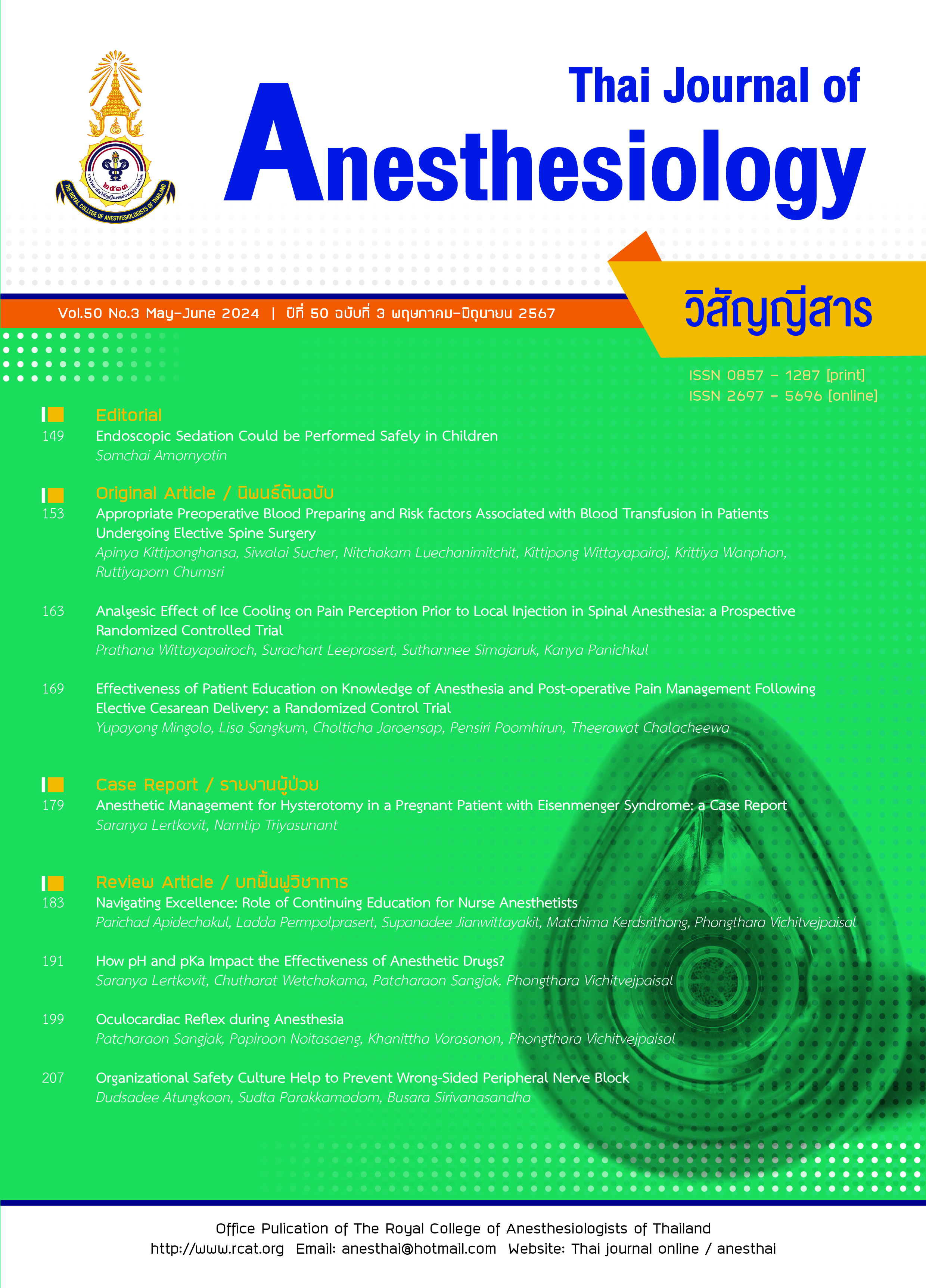Navigating Excellence: Role of Continuing Education for Nurse Anesthetists
Main Article Content
บทคัดย่อ
This article highlights the pivotal role of continuing nursing education (CNE). CNE serves as a catalyst for excellence, sharpening clinical knowledge, critical thinking, and patient care skills while being tailored to individual learning needs and styles. It emphasizes the importance of transparency, integrity, and ethical considerations in CNE to maintain its educational value. Moreover, the article underscores the transformative impact of CNE in equipping nurse anesthetists with evidence-based practices and the latest advancements, thereby enhancing patient safety and optimizing anesthesia care. Collaboration and networking with peers and experts, as well as participation in professional organizations and conferences, are emphasized for maximizing the benefits of CNE. The future of CNE is envisioned as a realm of personalized learning, interdisciplinary education, and integration of AI-driven adaptive learning methods. The commitment to ongoing professional development, patient-centered care, and the advancement of the profession is at the core of nurse anesthetists’ engagement with CNE. Ultimately, the journey through CNE empowers nurse anesthetists to thrive, adapt, and take leadership roles in an ever-changing healthcare environment, ultimately raising the standards of patient care.
Article Details

อนุญาตภายใต้เงื่อนไข Creative Commons Attribution-NonCommercial-NoDerivatives 4.0 International License.
เอกสารอ้างอิง
Davidson-Corbett D, Godwin C, McNeely H, Ramirez J, Smith J. CPD providers can positively impact practice by better understanding how APNs are educated, licenced, and certified. J CME. 2023;12:2160531.
Jeffries P. Clinical simulations in nursing education: advanced concepts, trends, and opportunities. Lippincott Williams & Wilkins. 2022;p1-5.
Stoffels M, Broeksma LA, Barry M, et al. Bridging between school and practice? Challenges to boundary objects in nursing education. VU
Research Portal. 2023:107.
Meeusen V, Pyhälä S, Gaskin D, et al. Nurse anesthetists: sharing our caring. In: Nurse practitioners and nurse anesthetists: the evolution of the global roles. Cham: Springer International Publishing. 2023;p433-54.
Al-Hassan M, Al Omari E. Simulation as a tool for continuous professional development unveiling excellence: harnessing simulation for lifelong learning in nursing practice. Saudi J Nurs Health Care. 2023;6:346-53.
Blumenshine C, Bickett A, Coroneos-Shannon D, Schoon S, Zidek S. Leveraging an interprofessional continuing education approach to empower
preceptors. J Contin Educ Nurs. 2023;54:293-6.
Graebe J, Cosme S. The foundation for operational excellence: being accredited by the American Nurses Credentialing Center. J Contin Educ Nurs. 2022;53:100-3.
Alexander JC, Romito BT, Çobanoglu MC. The present and future role of artificial intelligence and machine learning in anesthesiology. Int
Anesthesiol Clin. 2020;58:7-16.
Noone J, Gubrud P. Teaching in a practice-based profession. Best practices in teaching nursing, 1st edition, Wolters Kluwer. 2023;p1-5.
Scott JW, Lin Y, Ntakiyiruta G, et al. Identification of the critical nontechnical skills for surgeons needed for high performance in a variable-resource context (NOTSS-VRC). Ann Surg. 2019;270:1070-8.
LoBiondo-Wood G, Haber J. Nursing research e-book: methods and critical appraisal for evidence-based practice. Elsevier Health Sciences; 2021.
Chen Y, Cai Z, Lin B, et al. Developing a professional-practice-model-based nursing organizational informatics competency model. Int J Med Inform. 2022;166:104840.
Nordkvelle Y, Stalheim OR, Fossland T, de Lange T, Wittek AL, Nerland MB. Simulating: bridging the gap between practice and theory in higher professional education. Ensuring quality in professional education, Volume I: Human client fields pedagogy and knowledge structures. 2019;53-72.
Ledbeter L. Staff education… quick, easy e-access! J Perianesth Nurs. 2017;32:e27-8.
Jameson K. Surgical techniques and strategies: integrating anesthesia in general surgery. J Med Health Sci. 2023;1:112-36.
Wong LR, Flynn-Evans E, Ruskin KJ. Fatigue risk management: the impact of anesthesiology residents’ work schedules on job performance and a review of potential countermeasures. Anesth Analg. 2018;126:1340-8.
Ulit MJ, Eriksen M, Warrier S, et al. Role of the clinical nurse specialist in supporting a healthy work environment. AACN Adv Crit Care. 2020;31:80-5.
Yu X, Huang Y, Liu Y. Nurses’ perceptions of continuing professional development: a qualitative study. BMC Nurs. 2022;21:162.
Khanum S, de Souza MDL, Naz N, Sasso GTMD, Brüggemann OM, Heideman ITSB. The use of networking in nursing practice-An integrative review. Societies. 2016;6:22.
Rumeu-Casares C, Llacer T. Mentoring for continuity of a nursing professional practice model. In: Mentoring in nursing. Narrative stories across the world. Cham: Springer International Publishing; 2023;p581-8.
Cherkaoui Z, Merdinger-Rumpler C, Pessaux P, Lemaire C. Changing practices for an innovative care pathway, the mediating role of the coordinator. J Change Manag. 2024;24:50-68.
Marwaha RS, Bland L, Hicks J, et al. An interprofessional education initiative: Introducing a local anesthesia dental course for nurse practitioner and physician assistant students. J Dent Educ. 2023;87:1113-22.
Mlambo M, Silén C, McGrath C. Lifelong learning and nurses’ continuing professional development, a metasynthesis of the literature. BMC Nurs. 2021;20:62.


